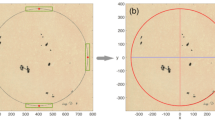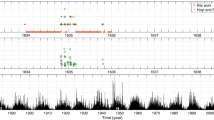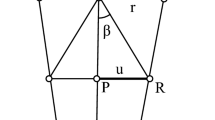Abstract
Digitized images of the drawings by J.C. Staudacher were used to determine sunspot positions for the period 1749 – 1796. From the entire set of drawings, 6285 sunspot positions were obtained for a total of 999 days. Various methods have been applied to find the orientation of the solar disk, which is not given for the vast majority of the drawings by Staudacher. Heliographic latitudes and longitudes in the Carrington rotation frame were determined. The resulting butterfly diagram shows a highly-populated Equator during the first two cycles (cycles 0 and 1 in the usual counting since 1749). An intermediate period is cycle 2, whereas cycles 3 and 4 show a typical butterfly shape. A tentative explanation may be the transient dominance of a quadrupolar magnetic field during the first two cycles.
Similar content being viewed by others
References
Arlt, R.: 2008, Digitization of sunspot drawings by Staudacher in 1749 – 1796. Solar Phys. 247, 399 – 410 (Paper I).
Balthasar, H., Vazquez, M., Wöhl, H.: 1986, Differential rotation of sunspot groups in the period from 1874 through 1976 and changes of the rotation velocity within the solar cycle. Astron. Astrophys. 155, 87 – 98.
Brandenburg, A., Spiegel, E.: 2008, Modeling a Maunder minimum. Astron. Nachr. 329, 351 – 357.
Bushby, P.J.: 2006, Zonal flows and grand minima in a solar dynamo model. Mon. Not. Roy. Astron. Soc. 371, 772 – 780.
Dikpati, M., Charbonneau, P.: 1999, A Babcock – Leighton flux transport dynamo with solar-like differential rotation. Astrophys. J. 518, 508 – 520.
Dikpati, M., Gilman, P.A.: 2001, Flux-transport dynamos with α-effect from global instability of tachocline differential rotation: A solution for magnetic parity selection in the Sun. Astrophys. J. 559, 428 – 442.
Hathaway, D.H., Nandy, D., Wilson, R.M., Reichmann, E.J.: 2003, Evidence that a deep meridional flow sets the sunspot cycle period. Astrophys. J. 589, 665 – 670.
Howard, R.F.: 1996, Axial tilt angles of active regions. Solar Phys. 169, 293 – 301.
Küker, M., Arlt, R., Rüdiger, G.: 1999, The Maunder minimum as due to magnetic Λ-quenching. Astron. Astrophys. 343, 977 – 982.
Maunder, E.W.: 1904, Note on the distribution of sun-spots in heliographic latitude, 1874 – 1902. Mon. Not. Roy. Astron. Soc. 64, 747 – 761.
Meeus, J.: 1985, Astronomical Formulae for Calculators, 3rd edn., Willmann-Bell, Richmond.
Ribes, J.C., Nesme-Ribes, E.: 1993, The solar sunspot cycle in the Maunder minimum AD1645 to AD1715. Astron. Astrophys. 276, 549 – 563.
Seidelmann, P.K., Abalakin, V.K., Bursa, M., Davies, M.E., de Bergh, C., Lieske, J.H., et al.: 2002, Report of the IAU/IAG Working Group on Cartographic Coordinates and Rotational Elements of the Planets and Satellites: 2000. Cel. Mech. Dyn. Astron. 82, 83 – 111.
Tobias, S.M.: 1997, The solar cycle: parity interactions and amplitude modulation. Astron. Astrophys. 322, 1007 – 1017.
Weiss, N.O., Tobias, S.M.: 2000, Physical causes of solar activity. Space Sci. Rev. 94, 99 – 112.
Wolf, R.: 1857, Mittheilungen üer die Sonnenflecken. Vierteljahressch. Naturforsch. Ges. Zürich 2, 272 – 299.
Zolotova, N.V., Ponyavin, D.I.: 2007, Was the unusual solar cycle at the end of the XVIII century a result of phase asynchronization? Astron. Astrophys. 470, L17 – L20.
Author information
Authors and Affiliations
Corresponding author
Rights and permissions
About this article
Cite this article
Arlt, R. The Butterfly Diagram in the Eighteenth Century. Sol Phys 255, 143–153 (2009). https://doi.org/10.1007/s11207-008-9306-5
Received:
Accepted:
Published:
Issue Date:
DOI: https://doi.org/10.1007/s11207-008-9306-5




